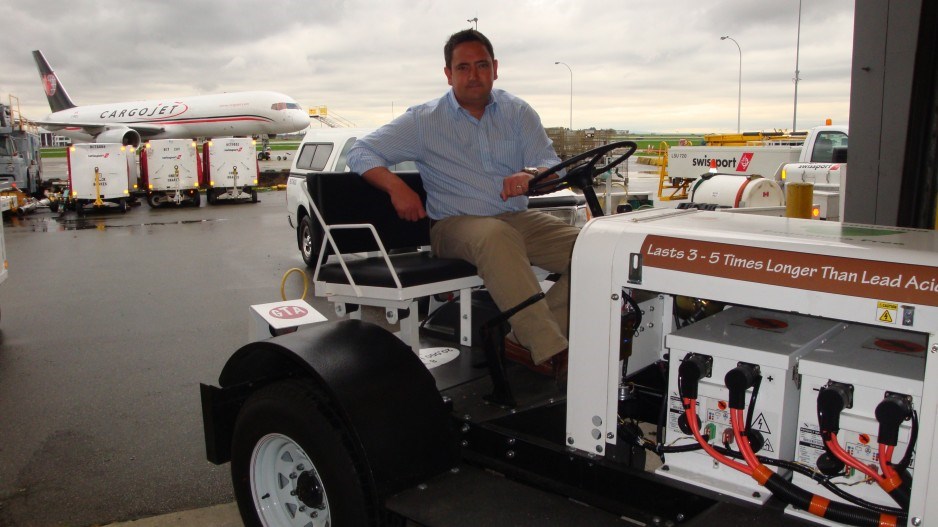It may be a while before airports see soundless, emission-free airplanes running on solar and battery power.
Until then, airlines like WestJet (TSX:WJA)can at least reduce their carbon footprints by switching their ground support equipment to battery power from gas.
WestJet is making that switch and using lithium battery power systems made by Corvus Energy
Ltd. in Richmond.
And while WestJet chose to announce its plans to convert its baggage handling equipment to rechargeable batteries from gas on Earth Day (April 22) in Calgary, reducing carbon emissions is “icing on the cake,” according to Sean Puchalski, vice-president of business development for Corvus.
“The environmental stuff is really not the lead story,” he said. “It’s the cost savings.”
Most of the equipment used at airports for ground support – baggage tractors and conveyor belt systems – is still gas powered. Gas has become so expensive that converting to rechargeable lithium battery systems is now a cheaper alternative.
“The day after you retrofit your vehicle, no more fuel bill,” Puchalski said. “And the other thing is maintenance costs. You take out the engine, the [transmission], the coolant system – all the high-maintenance stuff is gone.”
WestJet spokeswoman Jennifer Sanford said fuel andmaintenance costs are the two biggest drivers behind the switch to rechargeable batteries.
“As the price of oil continues to rise, so too does our need to find solutions that limit our reliance on fossil fuels. These electric tugs do provide us with a fuel saving, but they are also easier to maintain.”
WestJet has thus far converted three baggage tractors and one conveyor belt system. More conversions are planned.
Corvus started out making lithium battery systems primarily for the marine sector. The company’s power systems – which use lithium ion cells made by Dow Kokum – are used in hybrid tugboats and other vessels.
About a year ago, Corvus – which employs about 40 people – decided to diversify. That decision has paid off.
“We chose commercial trucking and ground support equipment,” Puchalski said. “We’ve got some initial contracts with major truck manufacturers. It’s going rather slowly, but positively, but on the ground support side, it’s taking off quickly, which is exciting.”
In addition to WestJet, Corvus is in talks with other aviation-related companies.
“We’ve signed on two additional customers besides WestJet,” Puchalski said. “We have a customer in the U.S. Department of Energy. We also have one of the largest parcel services in the world. We’re pretty excited about it, because with that contract, we have a beachhead into cargo operations now.”
Corvus estimates there are 150,000 pieces of ground support equipment at airports in North America that could be converted. Converting equipment used at ports and ferry terminals is another potential market.
“We’re budgeting to do about 120 units in the coming year,” Puchalski said, “but it could easily get up to a $15 million, $20 million-a-year business.”
However, there are other players competing for the ground support business, including makers of lead-acid battery systems.
Ballard Power Systems (TSX:BLD), which makes hydrogen fuel cell systems, is also looking into the gas-to-electric conversion sector.
Ballard makes distributed and backup power systems, along with fuel cells for transit buses and forklifts.
Since exhaust from gas-powered engines is hazardous in confined spaces, most forklifts used in warehouses are powered with rechargeable lead-acid batteries.
Hydrogen fuel-cell electrical systems don’t require recharging, which is why companies like Walmart (NYE:WMT) have switched to fuel-cell-powered forklifts from Plug Power Inc., which buys its fuel cells from Ballard.
Plug Power has sold about 2,000 such systems using Ballard fuel cells.
Ballard has also been investigating the aviation ground support space as a potential market.
“It’s a very similar solution to the one we’re using for forklifts today,” said Ballard account manager Gary Schubak.
“I think it’s a good next market, after forklifts.
“The value propositions are very similar. It’s about reducing greenhouse gas emissions, either by replacing battery vehicles or engine-based vehicles.” •




